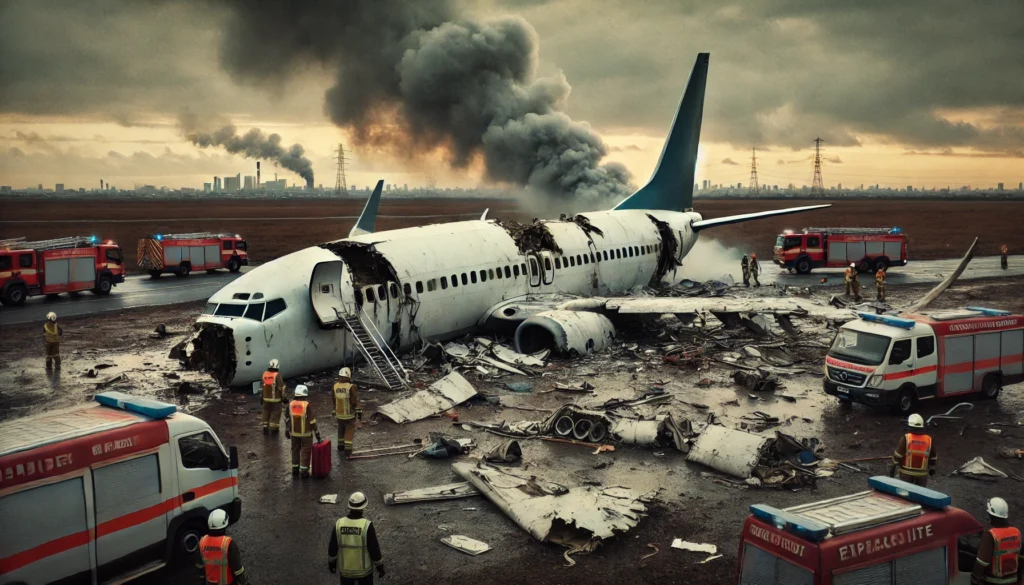Azerbaijan Plane Crash: How Safety Protocols Failed
The recent accident of an Azerbaijan Airlines flight has startled the aviation sector, raising serious questions about the region’s aviation safety procedures. This horrible tragedy exposed severe weaknesses, with 38 deaths and 29 survivors, including several critically injured. This article investigates the crash’s circumstances, potential causes, and safety implications for aviation. YouTube is filled with video news & content on Azerbaijan Plane Crash. But if you liked our content & news you can visit our site: Novel Stuff
What took place?
Azerbaijan Airlines Flight J2-8243, an Embraer 190, went down in Aktau, Kazakhstan, on December 25, 2024, when it was traveling from Baku, Azerbaijan to Grozny, Russia. The flight departed Baku at 03:55 GMT, but it crashed at 06:28 GMT after veering off course. 29 individuals survived the crash, 11 of them were in critical condition, while 38 people were killed, including both pilots. 62 passengers and 5 crew members from a number of countries, including Azerbaijan, Russia, Kazakhstan, and Kyrgyzstan, were on board the aircraft.
Potential Reasons for the Accident
Initial reports suggest that a bird strike caused the aircraft to swerve off course, while some sources believe that Russian air defense fire was involved, possibly in response to a Ukrainian drone threat. The specific cause of the crash is still under investigation. Authorities are thoroughly exploring all possibilities, including suspected mechanical problems and human error, because the cause is still unknown. Early results suggest that after the black box data is thoroughly studied, more clarity may emerge.
What is the investigation’s current status?
An detailed investigation into the incident has been launched by authorities, including the aviation safety institutions of Azerbaijan. To reconstruct the events leading up to the catastrophe, investigators are trying to recover crucial data from the flight data recorder and cockpit voice recorder, sometimes known as the “black box.” Although the possibility of outside involvement is being carefully considered along with other potential reasons, the precise cause will be identified following a thorough inquiry.
Although the likelihood of a bird assault was noted in previous accounts, which might have led to an emergency diversion or loss of control, speculation about Russian air defense fire in response to a possible Ukrainian drone threat presents challenging the investigation.
What does this mean for aviation safety?
This catastrophe has underlined the need for tougher aviation safety rules, particularly in areas of geopolitical conflict. Concerns have been raised about the following:
- Aircraft condition and maintenance checks: ensuring airlines adhere to tight maintenance schedules and thoroughly inspect aircraft prior to flight.
- Emergency Preparedness and Pilot Training: To deal with unforeseen scenarios such as bird attacks or external threats, pilots must acquire additional training.
- Advanced Communication Systems: In an emergency, especially when unexpected conditions such as air defense interference exist, improved communication between pilots, air traffic controllers, and ground authorities is critical.
It is more evident than ever that better protocols and communication in emergency situations are required in light of the complexity of this disaster.
Historical Events and Local Issues
Azerbaijan Plane Crash is not the only incident that has happened in the area. Similar questions concerning safety procedures and safeguards have been brought up by prior aviation tragedies. In order to improve air safety, future aviation regulations—especially in Kazakhstan and the neighboring areas—will probably be influenced by the current inquiry into this disaster.
Conclusion: A Call For Action
Azerbaijan Airlines Flight J2-8243’s sad disaster serves as a reminder of the continuous difficulties in maintaining aviation safety. Regulatory agencies must move quickly to address the impact of this accident, whatever of the cause—mechanical failure, human error, or outside meddling. It is imperative that the required modifications be implemented while the inquiry is ongoing in order to safeguard passengers flying throughout the region and stop such tragedies in the future.
This calamity should serve as a catalyst for fundamental changes in airline safety. To learn from this disaster and prevent future incidents, authorities must act quickly and decisively.
Check back for updates when more information from the investigation becomes available.
Frequently Asked Questions (FAQ)
1. What led to the Azerbaijan Plane Crash?
Investigations into the crash’s true cause are still ongoing. There is speculation that Russian air defense fire may have played a role, although early reports suggest that a bird attack caused the airplane to veer off course. The cause has not yet been established, and the investigation is still ongoing.
2. How many individuals were affected by the collision?
29 individuals survived the crash, 11 of them were in critical condition, while 38 people were killed, including both pilots. The travelers were from a number of countries, including Kyrgyzstan, Kazakhstan, Russia, and Azerbaijan.
3. How does the black box affect the investigation?
The black box, which contains the flight data recorder and cockpit voice recorder, is the primary tool for determining the cause of the catastrophe. It will provide critical information regarding the crew’s behavior, the plane’s performance, and any anomalies that may occur while in flight.
4. How will this disaster impact regional aviation safety?
The catastrophe has rekindled concerns over the region’s need for stricter aviation safety rules. To avert such catastrophes in the future, increased maintenance inspections, pilot training, and communication systems are required.
5. Was this the first Azerbaijan Plane Crash accident?
No, even though this is one of the most recent major airplane accidents in the area, it is not the first. Similar worries have been raised by past incidents, so it is imperative to continuously assess and improve aviation safety procedures.
6. When will the full findings of the investigation be accessible?
Although the initial results should be made public shortly, a thorough study that considers all likely reasons, including outside factors like air defense interference, could take months to finish.

